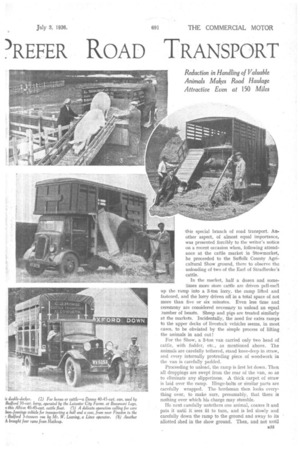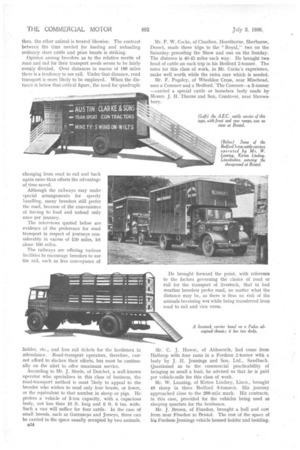WHY STOCK BREEDERS PREFER. ROAD TRANSPORT
Page 42

Page 43

Page 44

If you've noticed an error in this article please click here to report it so we can fix it.
THERE are opportunities for the use of road mechanical transport of animals to and from agricultural shows, considerably in excess of the average haulier's expectations. The Royal Show, now open at Bristol, is, of course, the largest and most important of such exhibitions. At a conservative estimate, it provides loads of horses and livestock, alone, for 400-500 journeys.
That figure is based on the average of five years' entries at the "Royal." These entries approximate to 600 horses, 1,200 head of cattle, 630 sheep, 650 pigs and a few goats. According to an authoritative statement by an official at the Show, more than half the total arrives by road. On that basis, there are 300 horses to be brought in horseboxes, say, 150 journeys ; 600 cattle, say, 270 journeys ; and, for the 315 sheep and 325 pigs, 60 journeys. The total is 480 journeys.
Those who are unacquainted with the special conditions under which this branch of transport is carried on may cavil at the above estimates of loadings, which provide for averages as follow :—Two horses per box ; rather more than two head of cattle per lorry load, and about 10 sheep and pigs. In ordinary circumstances, as when conveying animals to the market or slaughterhouse, these loadings are considerably exceeded.
When carrying animals for show purposes, however, the degree of crowding customary in these everyday transport operations is not permissible. Half the usual number of animals is all that can be carried. A considerable proportion of the load capacity, in bulk as well as in weight, is occupied by fodder, showyard accessories, and even groomsmen and herdsmen.
The foregoing indicates one of the conditions which should be borne in mind by all those who are studying B32 this special branch of road transport. An. other aspect, of almost equal importance, was presented forcibly to the writer's notice on a recent occasion when, following attendance at the cattle market in Stowmarket, he proceeded to the Suffolk County Agricultural Show ground, there to observe the unloading of two of the Earl of Stradbroke's cattle.
In the market, half a dozen and sometimes more store cattle are driven pell-mell up the ramp into a 3-ton lorry, the ramp lifted and fastened, and the lorry driven off in a total space of not more than five or six minutes. Even less time and ceremony are considered necessary to unload an equal .umber of beasts. Sheep and pigs are treated similarly at the markets. Incidentally, the need for extra ramps to the upper decks of livestock vehicles seems, in most cases,. to be obviated by the simple process of lifting the animals in and out!
For the Show, a 3-ton van carried only two head of cattle, with fodder, etc., as mentioned above. The animals are carefully tethered, stand knee-deep in straw, and every internally protruding piece of woodwork in the van is carefully padded.
Proceeding to unload, the ramp is first let down. Then all droppings are swept from the rear of the van, so as to eliminate any slipperiness. A thick carpet of straw is laid over the ramp. Hinge-bolts or similar parts are carefully wrapped. The herdsman then looks everything over, to make sure, presumably, that there is nothing over which his charge may stumble.
He next carefully untethers one animal, coaxes it and pats it until it sees fit to turn, and is led slowly and carefully down the ramp to the ground and away to its allotted shed in the show ground. Then, and not until
then, the other animal is treated likewise. The contrast between the time needed for loading and unloading ordinary store cattle and prize beasts is striking.
Opinion among breeders as to the relative merits of road and rail for their transport needs seems to be fairly evenly divided. Over distances in excess of 100 miles there is a tendency to use rail. Under that distance, road transport is more likely to be employed. When the distance is below that critical figure, the need for quadruple
changing from road to rail and back again more than offsets the advantage of time saved.
Although the railways may make special arrangements for speedy handling, many breeders still prefer the road, because of the convenience of having to load and unload only once per journey.
The interviews quoted below are evidence of the preference for road transport in respect of journeys considerably in excess of 150 miles, let alone 100 miles.
The railways are offering various facilities to encourage breeders to use the rail, such as free conveyance of
fodder, etc., and free rail tickets for the herdsmen in attendance. Road-transport operators, therefore, cannot afford to slacken their efforts, but must be continually on the alert to offer maximum service.
According to Mr. J. Steele, of Datchet, a well-known operator who specializes in this class of business, the road-transport method is most likely to appeal to the breeder who wishes to send only four beasts, or fewer, or the equivalent to that number in sheep or pigs. He prefers a vehicle of 3-ton capacity, with a capacious body, not less than 16 ft. long and 6 ft. 6 ins. wide. Such a van will suffice for four cattle. In the case of small breeds, such as Guernseys and Jerseys, three can be carried in the space usually occupied by two animals.
n34
Mr. F. W. Cocks, of Charlton, Horethorne, Sherborne, Dorset, made three trips to the "Royal," two on the Saturday preceding the Show and one on the Sunday. The distance is 40-45 miles each way. He brought two head of cattle on each trip in his Bedford 2-tonner. The rates for this class of work, in Mr. Cocks's experience, make well worth while the extra care which is needed.
Mr. F. Pugsley, of Wheddon Cross, near Minehead, uses a Commer and a Bedford. The Commer—a 3-tonner —carried a special cattle or horsebox body made by Messrs. J. H. Thorne and Son, Condover, near Shrewsbury.
He brought forward the point, with reference to the factors governing the choice of road or rail for the transport of livestock, that in bad weather breeders prefer road, no matter what the distance may be, as there is thus no risk of the animals becoming wet while being transferred from road to rail and vice versa.
Mr. C. J. Howse, of Aldsworth, had come from Hathrop with four rams in a Fordson 2-tormer with a body by J. H. Jennings and Son, Ltd., Sandbach. Questioned as to the commercial practicability of bringing so small a load, he advised us that he is paid per vehicle-mile for this class of work.
Mr. W. Leaning, of Kirton Lindsey, Lincs., brought 40 sheep in three Bedford 3-tonners. His journey approached close to the 200-mile mark. His contracts, in this case, provided for the vehicles being used as sleeping quarters for the herdsmen.
Mr. J. Brown, of Finedon, brought a bull and coir from near Finedon to Bristol. The rest of the space of his Fordson-Jennings vehicle housed fodder and bedding.




















































































